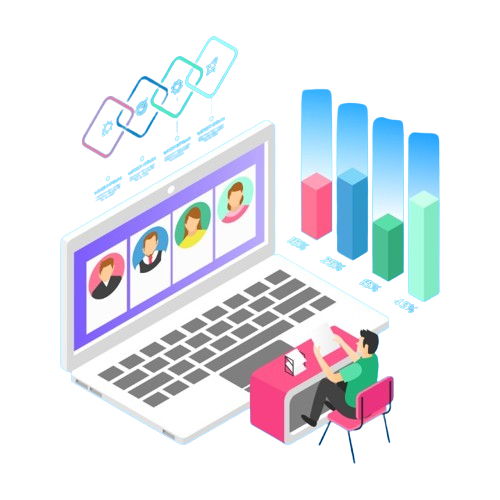Text
Efficient Remote Device Management: Improve Your Company
In today’s fast-paced digital era, remote work has evolved from a trend to a necessity. With the workforce dispersed across various locations, the effective management of devices, including remote monitoring, has emerged as a critical component for businesses striving to maintain productivity, security, and operational efficiency. In this blog, web development into the significance of remote device management and explore strategies to enhance your company's performance in the remote work landscape.

The Importance of Remote Device Management
In a remote work environment, remote device management holds immense importance for several reasons.
Security
With sensitive company data being accessed and transmitted across multiple devices, maintaining robust security measures, including device configuration, is paramount. Remote device management facilitates the implementation of encryption, access controls, and other security protocols to safeguard against unauthorized access and data breaches.
Compliance
High legal requirements about privacy and data protection apply to many businesses.
Effective remote device management ensures that devices remain compliant with relevant regulations, mitigating the risk of non-compliance penalties and legal repercussions.
Productivity
Well-managed devices are integral to enhancing employee productivity in a remote setting. By ensuring that devices are properly configured and maintained, employees can focus on their tasks without interruptions caused by technical issues or system failures.
Cost Efficiency
Proper management of devices can result in significant cost savings for organizations. By optimizing device usage, reducing downtime, and minimizing the risk of security incidents, companies can lower operational costs in the long run.

Strategies for Improving Remote Device Management
Centralized Management Tools
Implementing centralized management tools empowers IT administrators to remotely monitor and manage devices from a single interface. These tools facilitate tasks such as software updates, patch management, and troubleshooting, thereby saving time and resources.
Regular Maintenance and Updates
Establishing a schedule for regular maintenance tasks, including software updates and security patches, is crucial for keeping devices secure and optimized for performance. By staying proactive, organizations can mitigate potential vulnerabilities and ensure smooth operations.
Remote Access Solutions
Providing employees with secure remote access solutions enables them to connect to company networks and resources from any location. Virtual private networks (VPNs) and remote desktop solutions offer encrypted connections, ensuring data security while enabling seamless access to files and applications.
User Training and Education
Educating employees about best practices for device usage and security, including remote monitoring, is essential for maintaining a secure remote work environment. Training sessions on topics such as password management, phishing awareness, and data protection empower employees to make informed decisions and mitigate risks effectively.
BYOD Policies
Establishing clear BYOD policies that outline security requirements and guidelines for personal device usage is essential for managing the complexities of remote work environments. Implementing measures such as mobile device management (MDM) solutions and device enrollment programs ensures that personal devices adhere to corporate security standards.
Conclusion
Efficient remote device management is imperative for the success of modern businesses operating in remote or hybrid work environments. By prioritizing security, compliance, productivity, and cost efficiency, organizations can enhance their overall operations and empower employees to thrive in a remote-centric world. By adopting centralized management tools, implementing regular maintenance procedures, providing remote access solutions, offering user training, and establishing BYOD policies, companies can optimize device performance and achieve greater success in today’s digital age. Embracing these strategies will not only streamline remote device management but also bolster the resilience and competitiveness of the organization in an ever-evolving business landscape.
0 notes
Text
Effortless Efficiency: Managed Services Software
In today's competitive business world, efficiency is paramount. Managed services software is the catalyst, automating tasks and optimizing operations for sustainable growth. Delve into its transformative potential in revolutionizing modern business operations.
Managed services software streamlines IT management, cybersecurity, CRM, and project management. Explore its comprehensive applications, fostering collaboration and informed decision-making.
Ready to delve deeper? Click here to explore how to managed services software can transform your business operations.
Key Features and Benefits:
Automation: Streamline workflows and reduce manual tasks, saving time and resources.
Advanced Analytics: Gain valuable insights for continuous improvement and informed decision-making.
Scalability: Adapt quickly to evolving business needs, ensuring agility and competitiveness.
Security: Mitigate cybersecurity risks and safeguard sensitive data, enhancing overall security posture.
Discover more about the benefits of managed services software and its role in driving business success on our blog. click here to learn more about managed services software.
0 notes
Text
Effortless Efficiency: Managed Services Software
In today's competitive business world, efficiency is paramount. Managed services software is the catalyst, automating tasks and optimizing operations for sustainable growth. Delve into its transformative potential in revolutionizing modern business operations.
Managed services software streamlines IT management, cybersecurity, CRM, and project management. Explore its comprehensive applications, fostering collaboration and informed decision-making.
Ready to delve deeper? Click here to explore how to managed services software can transform your business operations.
Key Features and Benefits:
- Automation: Streamline workflows and reduce manual tasks, saving time and resources.
- Advanced Analytics: Gain valuable insights for continuous improvement and informed decision-making.
- Scalability: Adapt quickly to evolving business needs, ensuring agility and competitiveness.
- Security: Mitigate cybersecurity risks and safeguard sensitive data, enhancing overall security posture.
Discover more about the benefits of managed services software and its role in driving business success on our blog. click here to learn more about managed services software.
0 notes
Text
Cloud Disaster Recovery: Secure Your Data Safely
In today's data-driven world, safeguarding your assets against unforeseen disasters is paramount. Enter cloud disaster recovery (CDR) – a robust solution leveraging cloud technology to ensure uninterrupted business continuity. With CDR, businesses can mitigate risks associated with data loss or downtime effectively. By harnessing cloud infrastructure, CDR offers scalability, redundancy, and rapid recovery capabilities, empowering organizations to navigate challenges confidently. Explore the transformative potential of cloud disaster recovery to fortify your organization against disruptions and safeguard your valuable assets. Ready to delve deeper? Click here to discover more about cloud disaster recovery on our blog.
Understanding Cloud Disaster Recovery:
CDR mitigates data loss by replicating critical information in secure off-site locations, ensuring swift recovery in times of crisis.
Secure Data Storage:
Cloud-based solutions offer advanced encryption and security measures to safeguard against cyber threats and ensure data integrity.
Benefits of Cloud Disaster Recovery:
Embrace rapid recovery, scalability, cost efficiency, geographic redundancy, and automated processes with CDR.
Best Practices:
Conduct risk assessments, define recovery objectives, implement redundancy, and choose trusted partners to maximize CDR effectiveness.
Explore our blog for deeper insights into cloud disaster recovery and safeguard your business with confidence. Click here to learn more about cloud disaster recovery.
0 notes
Text
Software Business Ideas: Innovate, Create, Dominate
In today's rapidly evolving world, Software Business Ideas stand as beacons of innovation across industries. Dive into a realm where possibilities are endless, exploring solutions poised to redefine markets and fuel entrepreneurial triumph. From customized enterprise solutions to cutting-edge cybersecurity software, each idea holds the promise of transformative impact. Ready to embark on a journey of discovery? Explore our blog for deeper insights into the vast landscape of Software Business Ideas and unlock the keys to entrepreneurial success.
Customized Enterprise Solutions:
Tailored software solutions cater to unique business needs, offering efficiency and a competitive advantage.
Healthcare Management Software:
Navigate the healthcare landscape with innovative solutions for patient care and administrative tasks.
Financial Technology (FinTech) Solutions:
Disrupt traditional finance with convenient and secure digital platforms.
Cybersecurity Software:
Safeguard businesses from cyber threats with robust security solutions.
Educational Technology (EdTech) Platforms:
Meet the growing demand for online learning tools with interactive platforms.
Smart Home Automation:
Embrace IoT-driven automation for enhanced comfort and energy efficiency.
Agricultural Technology (AgriTech) Solutions:
Optimize farming practices with data-driven insights and precision agriculture techniques.
Unlock more insights on Software Business Ideas by click here to explore our blog. Dive into a world of innovation and entrepreneurial opportunities!
1 note
·
View note